

Our Results : The Author Incubator. Authors Cross-Promotion - Find reviews of book promotion sites and cross promote with fellow authors! Pronoun. Book Design. Book design encompasses size, margins, typography, line spacing, page numbers, headers and footers, page layout, parts of a book, cover design, and even your choice of paper.

The Chicago Manual of Style is the standard reference for designing a book. Wikipedia.org is also a good source of information. I will cover the more common elements here. If you get confused, remember, every book you own is a training aid. Book Design: Size Your first design decision is the size of your book. The most common size for trade paperbacks is 6 X 9 inches. Standard trim sizes available from CreateSpace for black and white interiors include: 5.25" X 8" 8" X 10"5.5" X 8.5" 8.25" X 8.25"6" X 9" 8.25" X 6"7" X 10" Understanding Book Layouts and Page Margins. When authors decide to format their own books, they don’t always make the best choices.
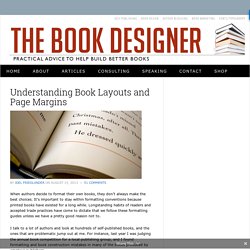
It’s important to stay within formatting conventions because printed books have existed for a long while. Longstanding habits of readers and accepted trade practices have come to dictate that we follow these formatting guides unless we have a pretty good reason not to. I talk to a lot of authors and look at hundreds of self-published books, and the ones that are problematic jump out at me. For instance, last year I was judging the annual book competition for a local publishing group, and I found formatting and book construction mistakes in many of the books produced by amateur publishers. Today, I want to look at one of the most common of these mistakes, and show you easy ways to avoid it.
Small Things Make a Big Difference I’m not going to deny that book designers are detail freaks. And that’s true for the decisions you make about margins, too. Do Margins Have Needs, Too? Tops and Bottoms. What are the margins for a 5x8 book. Creating a PDF for Print. If you're planning to submit your own fully-formatted files to CreateSpace for publication, you'll first need to format your book document according to CreateSpace specifications using our online submission guidelines.
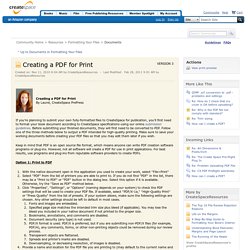
Before submitting your finished documents, they will first need to be converted to PDF. Follow one of the three methods below to output a PDF intended for high-quality printing. Make sure to save your working documents before creating your PDF files so that you may edit them later if you wish. Keep in mind that PDF is an open source file format, which means anyone can write PDF creation software programs or plug-ins. However, not all software will create a PDF for use in print applications. Option 1: Print to PDF With the native document open in the application you used to create your work, select "File>Print"Select "PDF" from the list of printers you are able to print to. Option 2: Export as PDF Option 3: Save as PDF You may also be interested in... A Step-By-Step Guide to Formatting Your Book's Interior. Has the idea for a novel recently hi-jacked your subconscious, or have you been drafting your dream on sticky notes since they were invented?
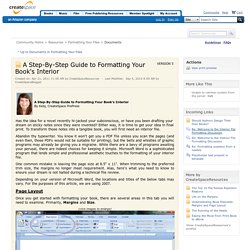
Either way, it is time to get your idea in final print. To transform those notes into a tangible book, you will first need an interior file. Abandon thy typewriter. You know it won't get you a PDF file unless you scan the pages (and even then, those PDFs would not be suitable for printing), but the bells and whistles of graphic programs may already be giving you a migraine. While there are a bevy of programs awaiting your perusal, there are indeed choices for keeping it simple. How to Set-up Your Book Size and Margins.
Regardless of the book size you choose, the margins will remain the same.
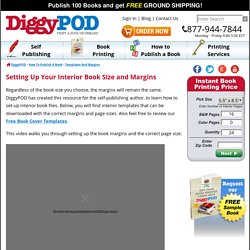
DiggyPOD has created this resource for the self-publishing author, to learn how to set-up interior book files. Below, you will find interior templates that can be downloaded with the correct margins and page sizes. How To Make A Book Perma-free on Amazon - All Fiction Writing. This is a post specifically for authors who self-publish on Amazon.
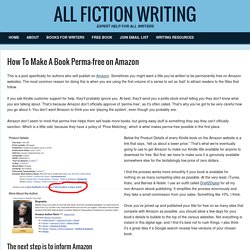
Sometimes you might want a title you’ve written to be permanently free on Amazon websites. The most common reason for doing this is when you are using the first volume of a series to act as ‘bait’ to attract readers to the titles that follow. If you ask Kindle customer support for help, they’ll probably ignore you. At best, they’ll send you a polite stock email telling you they don’t know what you are talking about. That’s because Amazon don’t officially approve of ‘perma-free’, as it’s often called. Amazon don’t seem to mind that perma-free helps them sell loads more books, but giving away stuff is something they say they can’t officially sanction. Below the Product Details of every Kindle book on the Amazon website is a link that says, “tell us about a lower price.”
What You Need to Know About Crowdfunded Publishing By Rocío Lara via Flickr Note from Jane: Today’s post is by guest Matt Kaye, who started his career in traditional publishing (Avalon, Wiley, FSG) and then spent the past four years at Amazon.

He recently joined Inkshares, a crowdfunded book publisher, in large part due to his interest in how crowdfunding might positively impact the publishing landscape. I asked him to explain the basics of crowdfunded publishing as well as the difference among various crowdfunding opportunities. As if deciding between self-publishing and traditional publishing wasn’t confusing enough for writers, you can now find publishing models that borrow elements from each.
An example is crowdfunded publishing, an option that is growing in popularity. An obvious reason to crowdfund is to cover your cost of hiring professional editors, designers, and marketers to publish a quality book, while maintaining creative control. Indiegogo: Indiegogo is a fundraising platform for any idea, not just creative projects. Related.